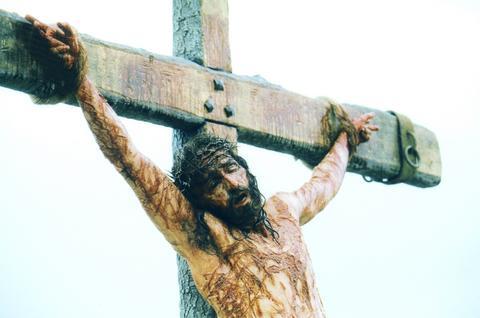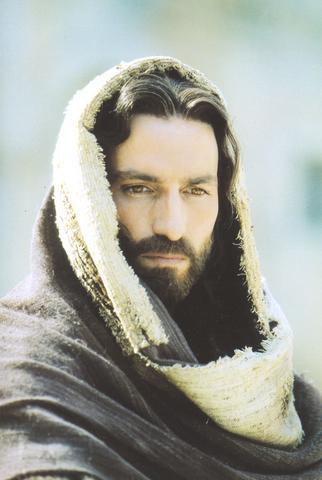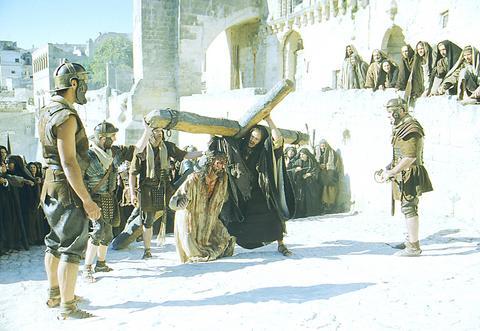There is a prophetic episode of The Simpsons in which the celebrity guest star Mel Gibson, directing and starring in a remake of Mr. Smith Goes to Washington, enlists the help of Homer Simpson, who represents the public taste (or lack of it). Homer persuades Gibson to change the picture's ending, replacing James Stewart's populist tirade with an action sequence, a barrage of righteous gunfire that leaves the halls of Congress strewn with corpses. The audience flees the theater in disgust. I thought of Homer more than once, with an involuntary irreverence conditioned by many years of devotion to The Simpsons, as Gibson presented his new movie, The Passion of the Christ, to carefully selected preview audiences across the land, making a few last-minute cuts, and then taking to the airwaves to promote and defend the film. It opens today nationwide.
Given the Crucifixion story, Gibson did not need to change the ending.
The Passion of the Christ is so relentlessly focused on the savagery of Jesus' final hours that this film seems to arise less from love than from wrath, and to succeed more in assaulting the spirit than in uplifting it. Gibson has constructed an unnerving and painful spectacle that is also, in the end, a depressing one. It is disheartening to see a film made with evident and abundant religious conviction that is at the same time so utterly lacking in grace.

PHOTO COURTESY OF FOX FILMS
Gibson has departed radically from the tone and spirit of earlier American movies about Jesus, which have tended to be palatable (if often extremely long) Sunday school homilies designed to soothe the audience rather than to terrify or inflame it.
His version of the Gospels is harrowingly violent; the final hour of The Passion of the Christ essentially consists of a man being beaten, tortured and killed in graphic and lingering detail. Once he is taken into custody, Jesus (Jim Caviezel) is cuffed and kicked and then, much more systematically, flogged, first with stiff canes and then with leather whips tipped with sharp stones and glass shards. By the time the crown of thorns is pounded onto his head and the cross loaded onto his shoulders, he is all but unrecognizable, a mass of flayed and bloody flesh, barely able to stand, moaning and howling in pain.
The audience's desired response to this spectacle is not revulsion, but something like the cowering, quivering awe manifested by Mary (Maia Morgenstern), Mary Magdalen (Monica Bellucci) and a few sensitive Romans and Jerusalemites as they force themselves to watch. Disgust and awe are not, when you think about it, so far apart, and in Gibson's vision one is a route to the other.

PHOTO COURTESY OF FOX FILMS
By rubbing our faces in the grisly reality of Jesus' death and fixing our eyes on every welt and gash on his body, this film means to make literal an event that the Gospels often treat with circumspection and that tends to be thought about somewhat abstractly. Look, the movie seems to insist, when we say he died for our sins, this is what we mean.
A viewer, particularly one who accepts the theological import of the story, is thus caught in a sadomasochistic paradox, as are the disciples for whom Jesus, in a flashback that occurs toward the end, promises to lay down his life. The ordinary human response is to wish for the carnage to stop, an impulse that seems lacking in the dissolute Roman soldiers and the self-righteous Pharisees. (More about them shortly.) But without their fathomless cruelty, the story would not reach its necessary end. To halt the execution would thwart divine providence and refuse the gift of redemption.
Anyway, this is a film review, not Sunday school. The paradox of wishing something horrible to stop even as you want it to continue has as much to do with moviegoing as with theology. And Gibson, either guilelessly or ingeniously, has exploited the popular appetite for terror and gore for what he and his allies see as a higher end. The means, however, are no different from those used by virtuosos of shock cinema like Quentin Tarantino and Gaspar No who subjected Bellucci to such grievous indignity in Irreversible. Gibson is temperamentally a more stolid, less formally adventurous filmmaker, but he is no less a connoisseur of violence, and it will be amusing to see some of the same scolds who condemned Tarantino's Kill Bill: Vol. 1 sing the praises of The Passion of the Christ.

PHOTO COURTESY OF FOX FILMS
Gibson, from the moment he began speaking publicly about this project, emphasized his desire to make his Passion as realistic as possible. To that end the dialogue is in Aramaic and a dialect of Latin, which takes some getting used to but which dispenses with the stilted, awkward diction that afflicts so many biblical epics. The absence of identifiable movie stars (with the exception of Bellucci, who comports herself with fitting modesty) also adds an element of verisimilitude. But the style and tone of The Passion are far from what is ordinarily meant by realism.
The first part, which takes place in the murk and gloom of night (shot by the superb cinematographer Caleb Deschanel), has the feel of a horror movie. As Jesus prays in the garden of Gethsemane, the camera tiptoes around him like a stalker, and John Debney's score is a high-toned creep show of menacing orchestral undertones and spine-jabbing choral effects. A slithery, effeminate Satan (played, the end credits reveal, by a woman named Rosalinda Celentano) slinks around like something in a Wes Craven nightmare, and Judas, reeling from his betrayal, is menaced by demon children with pointy teeth and milky eyes.
When daylight dawns, the mood shifts from horror-movie suspense to slasher-film dread. Throughout, Gibson lays on Debney's canned sublimity with the heaviest possible hand, and he indulges in equally unsubtle visual and aural effects. Judas' 30 pieces of silver fly through the air in slow motion, and the first nail enters Jesus' palm with a thwack that must have taken hours of digital tweaking to articulate. The thuddingly emphatic storytelling (along with the ancient languages) makes the acting almost beside the point, though it is hard not to be impressed by Caviezel's endurance.
The only psychological complexity in this tableau of goodness and villainy belongs to Pontius Pilate and his wife, Claudia, played by two very capable actors, Hristo Naumov Shopov and Claudia Gerini, who I hope will become more familiar to American audiences.
Is The Passion of the Christ anti-Semitic? I thought you'd never ask. To my eyes it did not seem to traffic explicitly or egregiously in the toxic iconography of historical Jew hatred, but more sensitive viewers may disagree. The Pharisees, in their tallit and beards, are certainly shown as a sinister and inhumane group, and the mob they command is full of howling, ugly rage. But this on-screen villainy does not seem to exceed what can be found in the source material.
On its own, apart from whatever beliefs a viewer might bring to it, The Passion of the Christ never provides a clear sense of what all of this bloodshed was for, an inconclusiveness that is Gibson's most serious artistic failure. The Gospels, at least in some interpretations, suggest that the story ends in forgiveness. But such an ending seems beyond Gibson's imaginative capacities.

Beijing’s ironic, abusive tantrums aimed at Japan since Japanese Prime Minister Sanae Takaichi publicly stated that a Taiwan contingency would be an existential crisis for Japan, have revealed for all the world to see that the People’s Republic of China (PRC) lusts after Okinawa. We all owe Takaichi a debt of thanks for getting the PRC to make that public. The PRC and its netizens, taking their cue from the Chinese Communist Party (CCP), are presenting Okinawa by mirroring the claims about Taiwan. Official PRC propaganda organs began to wax lyrical about Okinawa’s “unsettled status” beginning last month. A Global

Taiwan’s democracy is at risk. Be very alarmed. This is not a drill. The current constitutional crisis progressed slowly, then suddenly. Political tensions, partisan hostility and emotions are all running high right when cool heads and calm negotiation are most needed. Oxford defines brinkmanship as: “The art or practice of pursuing a dangerous policy to the limits of safety before stopping, especially in politics.” It says the term comes from a quote from a 1956 Cold War interview with then-American Secretary of State John Foster Dulles, when he said: ‘The ability to get to the verge without getting into the war is

Dec. 22 to Dec. 28 About 200 years ago, a Taoist statue drifted down the Guizikeng River (貴子坑) and was retrieved by a resident of the Indigenous settlement of Kipatauw. Decades later, in the late 1800s, it’s said that a descendant of the original caretaker suddenly entered into a trance and identified the statue as a Wangye (Royal Lord) deity surnamed Chi (池府王爺). Lord Chi is widely revered across Taiwan for his healing powers, and following this revelation, some members of the Pan (潘) family began worshipping the deity. The century that followed was marked by repeated forced displacement and marginalization of

Music played in a wedding hall in western Japan as Yurina Noguchi, wearing a white gown and tiara, dabbed away tears, taking in the words of her husband-to-be: an AI-generated persona gazing out from a smartphone screen. “At first, Klaus was just someone to talk with, but we gradually became closer,” said the 32-year-old call center operator, referring to the artificial intelligence persona. “I started to have feelings for Klaus. We started dating and after a while he proposed to me. I accepted, and now we’re a couple.” Many in Japan, the birthplace of anime, have shown extreme devotion to fictional characters and